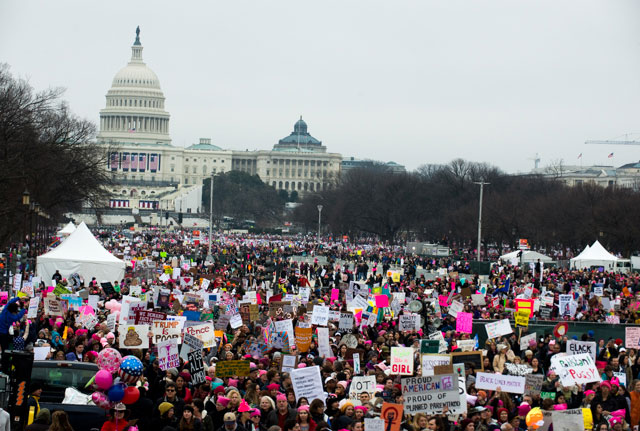
“Welcome to your first day! We won’t go away!”
“This is what democracy looks like!”
Women’s rights supporters from all over the country descended on the National Mall Saturday, January 21, in a show of strength and unity, waving signs and chanting in opposition to the newly inaugurated Donald Trump administration.
Crowd scientists estimate that at least three times as many people were on the Mall for the Women’s March on Washington than the day before to hear President Trump take the oath of office — and the conservative 470,000 estimate reported in The New York Times doesn’t include those who were spread out beyond the scope of aerial photographs who marched into the evening. The Guardian estimated that participation in the Washington march reached 1 million.
More than 500 organizations partnered with the national organizers, who estimate that sister marches around the world from Antarctica to Zimbabwe in 673 cities hosted another 4,721,500 participants.
Unlike many marches, Saturday’s mobilization was full of young children with homemade signs joining in chants like “My body, my choice!” As one mother worked her way through the crowd on the National Mall with her three young daughters, she called out encouragements that also captured the spirit of the day: “Take your space! Keep your shoulders broad. Just because you’re small doesn’t mean you can’t keep your space.”
First-Time Protesters Join With Longtime Activists
Truthout spoke with some of those in attendance, many of whom were marching for the first time in their lives. Others said they have been protesting off and on their entire lives.
Camille Jackson came from Pennsylvania to meet her mother, Tammy Jackson, who had come from Virginia for her first demonstration.
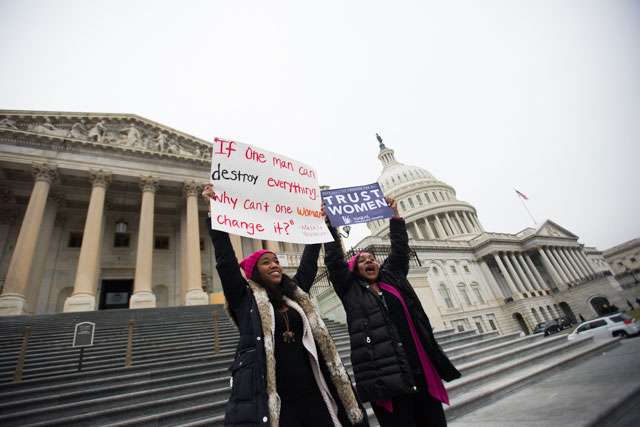 Camille and Tammy Jackson wave signs on the steps of the US Capitol Building, to cheers from the incoming Women’s Marchers. (Photo: Zach Roberts)
Camille and Tammy Jackson wave signs on the steps of the US Capitol Building, to cheers from the incoming Women’s Marchers. (Photo: Zach Roberts)
“I did a Black Lives Matter protest at Penn State, where I go to school, and it was amazing, so this is my first women’s rights march,” Camille said. “I’m here for the future … The new generation is super-inclusive and I’m here to fight for them,” she added, tearing up as she explained that she’s a program coordinator for a youth-focused nonprofit.
She plans to take the message of the march home through “resistance, peace, love, unity and working with everyone.”
Tammy also fought back tears as she told Truthout why she was there.
“I am here because I am a woman and I support women’s rights and I oppose just about everything that Donald Trump stands for,” she said. “I want to be a voice for women. I want to be a voice for my daughters and — here we go with the waterworks. Just like I said, everything [Trump] said [about] women’s rights, sexual assault, things he said about abortion and ‘women should be punished’ — I just don’t agree with anything.”
Tammy was moved by reports of the signs unfurled from bridges around the world saying, “Build bridges, not walls.”
“I think the time is now to stand strong, to unite [our] voices to unite for this cause and just to rise up peacefully — protest and demonstrate around the world to unify our voices,” she said. “I’m so glad that the world is standing behind us … at the Brandenburg Gate, on bridges and places around the world. It’s wonderful, it’s wonderful.”
Like her daughter, Tammy says she’s planning to stay involved.
“I think this year, if anything, has shown us we need to get involved locally — in our local governments, state government and to rally together to do like what Obama did when he started out,” she said. “We need grassroots campaigns, we need to go door to door, we need to educate our people — we need to educate everybody on what it is we need to accomplish!”
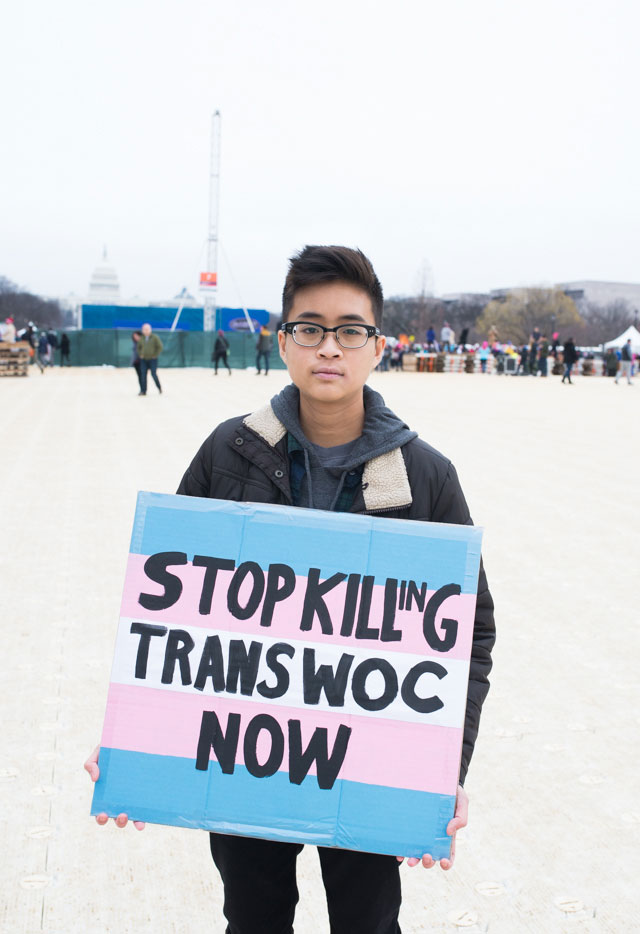 Thy Barsell, a non-binary protester, marched for the trans community, and is worried what a Trump administration would bring. (Photo: Zach Roberts) Thy Barsell, a 19-year-old non-binary Virginia resident, traveled alone to Washington, DC, for the March.
Thy Barsell, a non-binary protester, marched for the trans community, and is worried what a Trump administration would bring. (Photo: Zach Roberts) Thy Barsell, a 19-year-old non-binary Virginia resident, traveled alone to Washington, DC, for the March.
“I’ve been to political rallies before for the election,” they said. “I’m here today to show support for all the marginalized groups — women, trans women, trans people, Black women, immigrants — all those that are oppressed and have considered powerlessness in the nation under a Trump administration.”
Barsell felt inspired by the march and the speakers.
“It gave me a passion for social justice,” they said. “I’m planning on being more involved on my campus with Planned Parenthood; I’m planning on marching more in political and public protests.”
Mary Gomez, a 68-year-old Democrat from Indiana, said she traveled to the march because, “I’m a woman and I feel that our very existence is threatened.”
She laughed when asked if this was her first protest.
“Oh, hell no, I was here in ’68 … We’re still protesting the same shit!” she told Truthout. “It’s very affirming to come here and see all the signs and all the hope and positivity.”
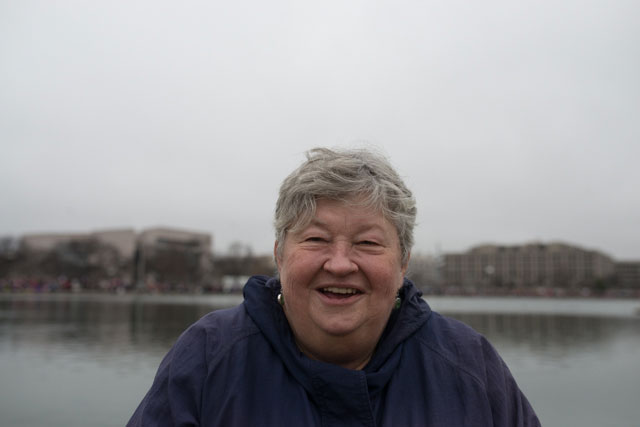 Mary Gomez traveled from Indiana to Washington, DC, for the Women’s March, saying, “I’m Democrat, I’m a woman and I feel that our very existence is threatened.” (Photo: Zach Roberts)
Mary Gomez traveled from Indiana to Washington, DC, for the Women’s March, saying, “I’m Democrat, I’m a woman and I feel that our very existence is threatened.” (Photo: Zach Roberts)
Gomez is holding on to that positivity with both hands and staying involved because “where there’s life, there’s hope.”
Meanwhile 23-year-old Maggie, a “very liberal” registered Democrat from Pennsylvania, told Truthout that the march was her first protest. She was there to stand up for human rights — health care, in particular.
“I’m worried about the repeal of the Affordable Care Act,” she said. I just don’t think that they have a very set plan for what’s going to happen in the future, and that scares me.”
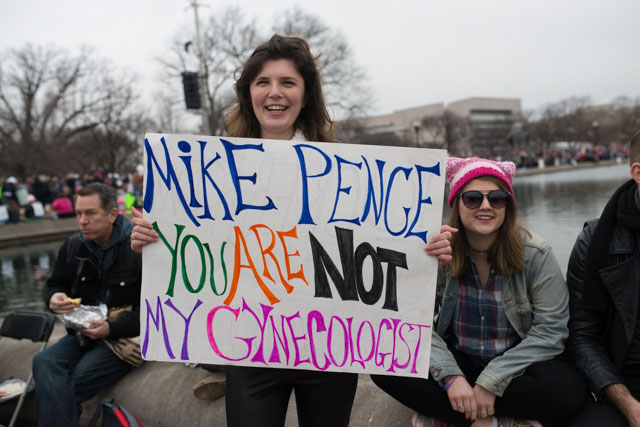 This is Maggie’s first protest and she’s looking forward to more. She works in the health care industry and is concerned that the people she works with will be adversely affected by the removal of ACA. (Photo: Zach Roberts)
This is Maggie’s first protest and she’s looking forward to more. She works in the health care industry and is concerned that the people she works with will be adversely affected by the removal of ACA. (Photo: Zach Roberts)
Her ACA worries prompted her to email nonprofits and her senator about Trump’s nominee for attorney general, Sen. Jeff Sessions (R-Alabama).
“[Sessions] scares me more than anything,” she said. “I work in the insurance world, so I work with people that are covered through Obamacare, accessing their benefits. So we’re just there to support people who are scared and don’t know what’s going to happen. I do my best to be an active citizen.”
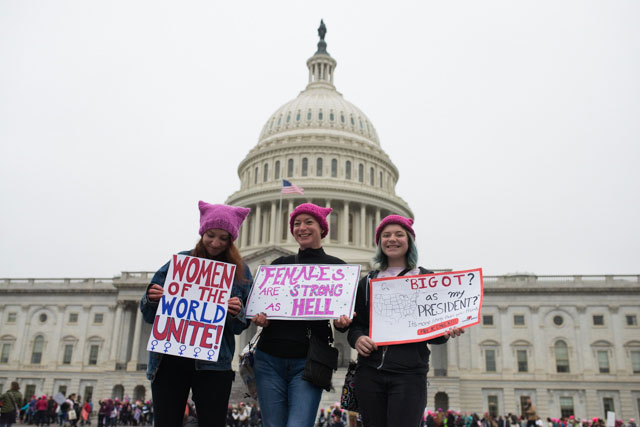 Three women stand in front of the US Capitol Building posing for a photo before joining the hundreds of thousands already at the Women’s March on the Mall. (Photo: Zach Roberts)
Three women stand in front of the US Capitol Building posing for a photo before joining the hundreds of thousands already at the Women’s March on the Mall. (Photo: Zach Roberts)
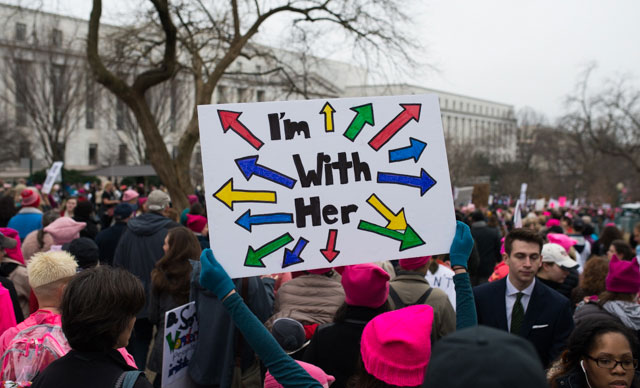 One of the hundreds of thousands that took to the nation’s capital holds a home made sign that plays on Hillary’s campaign slogan “I’m with her.” (Photo: Zach Roberts)
One of the hundreds of thousands that took to the nation’s capital holds a home made sign that plays on Hillary’s campaign slogan “I’m with her.” (Photo: Zach Roberts)
The March’s Contentious Organizing Process
Linda Sarsour, a Palestinian-American activist and cofounder of MPower Change, became a co-chair of the Women’s March on Washington and described the process that brought dozens of individuals and hundreds of organizations together for “the largest mass mobilization any administration has seen on its first day” as “contentious … by design.” Many of those involved had never met, and the internal push for greater intersectionality and inclusion created expected bumps in the road.
Early criticisms of the march pointed to the lack of organizers of color, and the lack of emphasis on issues primarily faced by women of color. Over the past couple of months, efforts were made to broaden the backgrounds of those involved behind the scenes and on stage for the main event.
“As women of color who came into this effort, we came in not only to mobilize and organize, but also to educate — to argue that we can’t talk about women’s rights, about reproductive rights, about equal pay, without also talking about race and class,” Sarsour told The Cut’s Rebecca Traister before the march. “We’re actually okay with people being offended. We are hoping that the conversation continues and that we can move into a different place and focus on the way that we’re coming together nonetheless.”
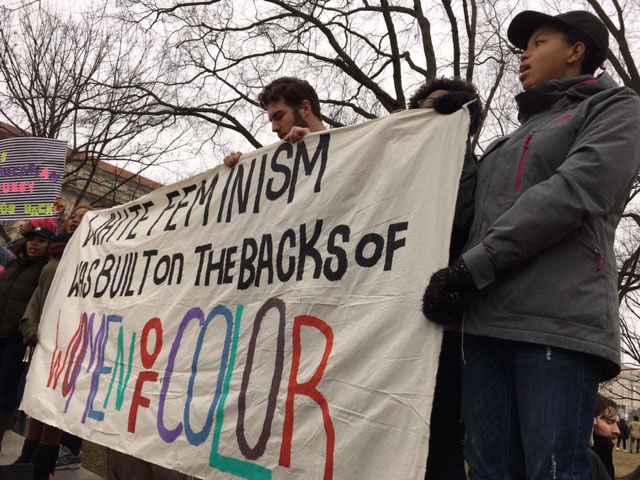 Protesters on Independence Avenue in Washington, DC, offer a reminder to white marchers that women of color have been fighting oppression long before the rise of Trump. (Photo: Rebekah Frumkin)
Protesters on Independence Avenue in Washington, DC, offer a reminder to white marchers that women of color have been fighting oppression long before the rise of Trump. (Photo: Rebekah Frumkin)
Among those on the stage with Sarsour on Saturday were Ai-jen Poo, director of the National Domestic Workers Alliance; Melissa Harris-Perry, director of the Anna Julia Cooper Center and editor-at-large of Elle Magazine; Raquel Willis, communications associate for the Transgender Law Center; Sybrina Fulton, the mother of Trayvon Martin; and Janet Mock, the author, speaker, MSNBC host and founder of the #GirlsLikeUs campaign to empower transgender women.
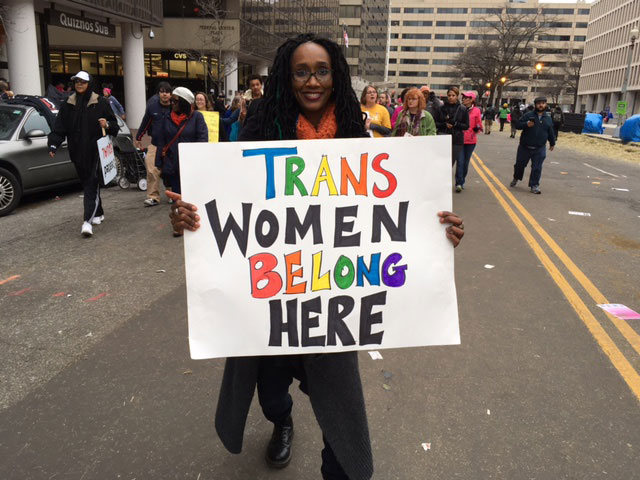 A protester on C Street reminds trans women that they are welcome at the march in Washington, DC. (Photo: Rebekah Frumkin)
A protester on C Street reminds trans women that they are welcome at the march in Washington, DC. (Photo: Rebekah Frumkin)
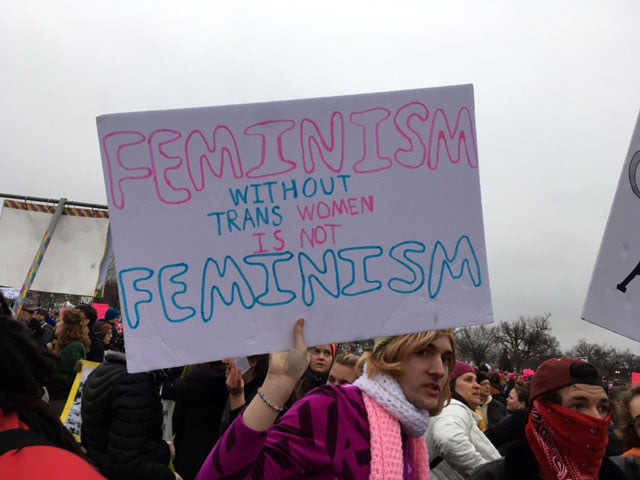 A protester on the lawn in front of the White House carries a sign demanding the inclusion of trans women in feminist ideology. (Photo: Rebekah Frumkin)
A protester on the lawn in front of the White House carries a sign demanding the inclusion of trans women in feminist ideology. (Photo: Rebekah Frumkin)
Mock was involved with writing the official Women’s March policy platform and gave one of the most powerful keynote speeches on Saturday, which included this passage:
Our approach to freedom need not be identical, but it must be intersectional and inclusive. It must extend beyond ourselves. I know with surpassing certainty that my liberation is directly linked to the liberation of the undocumented trans Latina yearning for refuge. The disabled student seeking unequivocal access. The sex worker fighting to make her living safely.
Collective liberation and solidarity is difficult work; it is work that will find us struggling together and struggling with one another. Just because we are oppressed does not mean that we do not ourselves fall victim to enacting the same unconscious policing, shaming and erasing. We must return to one another with greater accountability and commitment to the work today.
By being here you are making a commitment to this work.
Mock’s deliberate inclusion of sex workers’ rights in the platform and in her speech is itself historic. Sex workers have long been ignored, stigmatized and often criminalized within mainstream feminism, and others on the main stage, including Gloria Steinem, have remained resistant at best to the idea that “sex work is work” and that decriminalization should be a tenet of the broader movement. Mock told activist Melissa Gira Grant, an advocate for sex workers’ rights, last week that including her line “we stand in solidarity with sex workers’ rights movements” in the platform was “not controversial to me because, as a trans woman of color who grew up in low-income communities and who advocates, resists, dreams and writes alongside these communities, I know that underground economies are essential parts of the lived realities of women and folk. I know sex work to be work. It’s not something I need to tiptoe around.”
Another point of contention in the lead-up to the event was the lack of disability rights and disability justice speakers.
Writer and disability justice advocate Emily Ladau published a thorough breakdown of the Women’s March’s “Unity Principles” five days before the event.
“The first time the word ‘disabilities’ is mentioned, it shows zero recognition of disability as a social justice issue,” Ladau wrote, referring to a brief mention of people with disabilities in the context of a bullet point focused on the labor of paid and unpaid caregivers. She added: “You know what it says to me, that this bullet point is one of only two places where disability is mentioned in the entire platform released by the Women’s March? It says that my existence as a disabled woman is a ‘burden.’ My existence as a disabled woman is ‘work’ for someone else.”
The following day, January 17, the official Women’s March account tweeted, promising to make positive changes toward disability inclusion: “A great piece from @emily_ladau on how disability can intersect with every identity/issue. A must-read! TY to Emily for pushing us!” Ladau’s criticism that “not a single disability organization is represented among the lengthy list of contributors to the platform” was not addressed.
Writer/organizers Sonya Huber, Sarah Einstein and Andrea Scarpino, together with other contributors, created the Disability March website as a way for those who were unable to participate in person at the National Mall due to disability to build community through an online march.
Controversies Over Anti-Choice Groups
Controversies also erupted over the temporary inclusion of two anti-choice groups — And Then There Were None and New Wave Feminists — on the march’s online partnership page during the lead-up to the march.
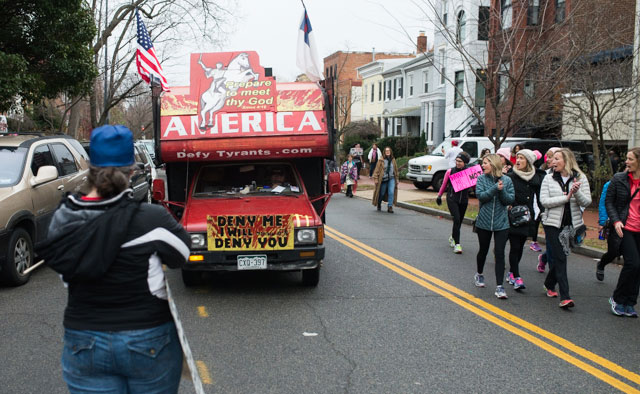 A truck plastered with religious and extreme anti-abortion views slowly follows Women’s Marchers to the Capitol. (Photo: Zach Roberts)
A truck plastered with religious and extreme anti-abortion views slowly follows Women’s Marchers to the Capitol. (Photo: Zach Roberts)
Iranian-American feminist organizer Lily Bolourian was among the loudest voices demanding these anti-choice groups’ removal from the partner list. The response from the march stated: “The anti-choice organization in question is not a partner of the Women’s March on Washington. We apologize for this error.”
“After quietly removing New Wave Feminists from their partnership page because of heavy backlash, the statement that [march organizers] issued was unsatisfactory, to say the least. Partnering with a group that likens Planned Parenthood to Mengele [the Nazi officer known for his horrific medical experiments in Auschwitz] is kind of a big ‘error’ to make. People wanted an explanation, and deserved one, but we didn’t get it,” Bolourian told Truthout.
Bolourian’s frustrations intensified when she returned to the official website to check for other sponsors.
“The march has made it clear that it’s sympathetic to anti-choice causes and people,” she said. “As if And Then There Were None being added after the initial backlash before [and then] being quietly removed after wasn’t bad enough. They are partnered with Stanton Healthcare — a [‘crisis pregnancy center’, aka fake reproductive clinic] chain with the expressed purpose of undermining and gutting Planned Parenthood. That’s not my feminism. No thanks.”
Stanton was eventually removed from the partnership list as well, due to pushback.
Concerns Over Appropriation and Racism
Bolourian had been one of many who were initially excited about an event that invoked the historic March on Washington and hoped that the organizers were Black women. When she found out that the early group was mainly made up of white women, she lost interest, expecting it to be yet another instance of appropriation.
Brittany Oliver, a women’s rights activist in Baltimore, spoke up about the appropriation in November on her website:
In the beginning, the march was named “One Million Woman,” and soon after being made aware you were co-opting a march led by Black women in 1997, then you decided to change the name to “March on Washington.” Well, this was another Black-led march that advocated for civil rights.… Overall, you all have co-opted the messaging of these two very important historical moments in Black history and it’s unfortunate because it’s becoming increasingly difficult to preserve Black activism.
Eventually, organizers reached out and broadened their team and partners to include young people, women of color and folx of different genders and faiths.
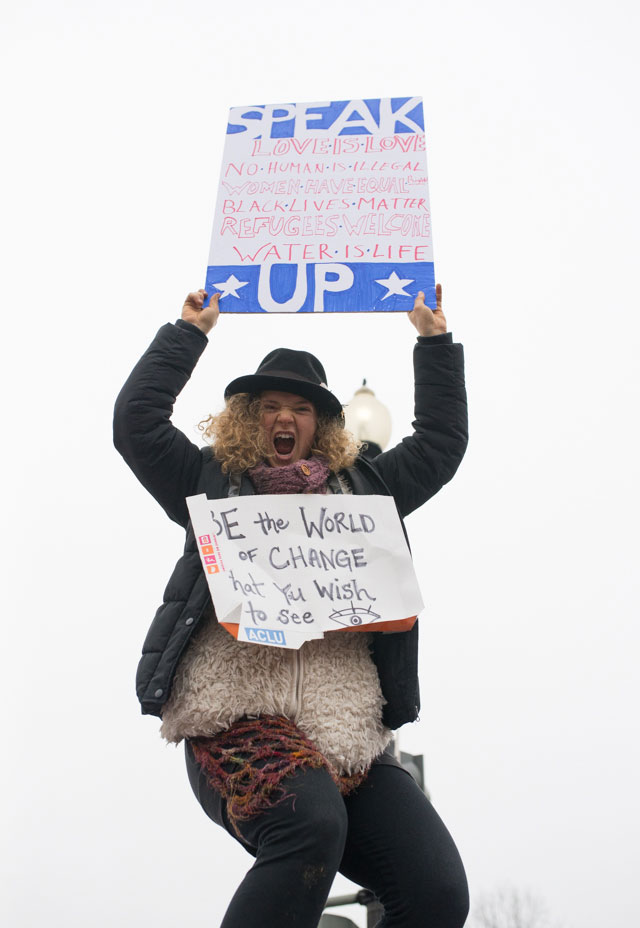 Women’s Marchers took to every open space, holding signs and chanting — even the Capitol’s sign posts and electric boxes were taken up. (Photo: Zach Roberts)“Changes were made to leadership, which was really promising,” said Bolourian. “But after taking a look at their site, I noticed Eve Ensler and One Billion Rising were partnered with them and my heart sank. It is not new or groundbreaking to say Ensler has been exploitative and racist in her work. If we are going to hold the mantle of progressivism, we need to have some kind of value system. If someone is deeply problematic and unwilling to change, why are we rewarding them by signing them up as a partner? It doesn’t make sense to me.”
Women’s Marchers took to every open space, holding signs and chanting — even the Capitol’s sign posts and electric boxes were taken up. (Photo: Zach Roberts)“Changes were made to leadership, which was really promising,” said Bolourian. “But after taking a look at their site, I noticed Eve Ensler and One Billion Rising were partnered with them and my heart sank. It is not new or groundbreaking to say Ensler has been exploitative and racist in her work. If we are going to hold the mantle of progressivism, we need to have some kind of value system. If someone is deeply problematic and unwilling to change, why are we rewarding them by signing them up as a partner? It doesn’t make sense to me.”
Ensler’s annual One Billion Rising has faced criticism for erasure and silencing as well as co-opting over the past several years. As Lauren Chief Elk-Young Bear wrote four years ago at Model View Culture:
The actions made by V-Day on February 14, 2013 bulldozed and railroaded existing grassroots organizing by Indigenous women, and then attempted to silence Indigenous women for dissenting. This was not the first time that V-Day and Ensler were condemned by Indigenous women, and these actions are unfortunately emblematic of mainstream feminism and its anti-violence movement.
In July 2013, Ensler also claimed in an open letter to Trayvon Martin following the acquittal of his murderer that “things that I have experienced that bring us into the same story, the same struggle.”
Rewire News editor Regina Mahone responded at the time:
I don’t think a letter to Martin was the right place to push an agenda about [Ensler’s] campaign to end violence against women, especially without first acknowledging the fear many people are taught to feel about men of color — a fear that is just as present in the women’s movement as it is in each of the United States of America … [Ensler] had an opportunity to address this issue of race, particularly in the women’s movement, but she blew it.
Bolourian said she wasn’t telling anyone else not to go, but was focusing on organizing closer to home.
“I want to use my energy to resist fascists by protesting on inauguration day. I think that is where people are needed most. Locals have been courageously organizing and that is a better use of my time,” she said as she looked ahead beyond this weekend. “I think the [Women’s March] platform is a good start, but it is incomplete. I wanted to see more on emotional labor, fully-funded abortions instead of ‘affordable’ ones, an anti-imperialist foreign policy that protects women and girls abroad, Native sovereignty, murders of trans women. There is work to be done.”
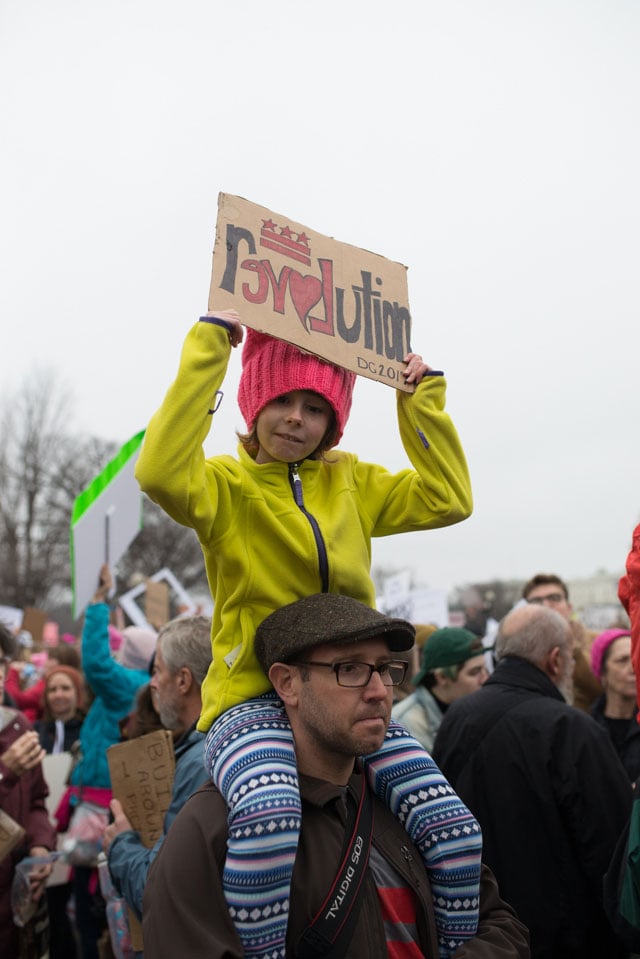 The Women’s March was a family affair with kids and adults of all ages taking to the streets and warning Trump that they weren’t going away. (Photo: Zach Roberts)Participating in the March Despite Concerns
The Women’s March was a family affair with kids and adults of all ages taking to the streets and warning Trump that they weren’t going away. (Photo: Zach Roberts)Participating in the March Despite Concerns
While criticisms were plentiful ahead of the event, many with concerns about various aspects of it decided to show up regardless, in order to take part in the mass mobilization.
“I went to the march because, like loads of other people, I am terrified of our new administration and the havoc they will wreak on our world,” feminist writer Aja Barber told Truthout. “This man ran a campaign on fear and when someone makes grandiose statements around registering minority groups, I tend to believe them!”
Barber found mostly what she expected at the march.
“I got the vibe the majority of the marchers didn’t understand that dismantling white supremacy should be at the top of their lists, right next to stopping Trump from infringing on their rights,” Barber said. “I’ll be going to more marches, but I’ll also be pushing activists and people who claim to be allies to do better.”
With hope, the many people who took part in the march — including the many children of all ages in attendance — not just in DC, but in marches across the country — will continue to participate in future political mobilization as well, creating more opportunities to keep this momentum alive and also to do better.
 Amy Walker from Cherokee, North Carolina, who recently returned from Standing Rock was concerned what Trump might do to Indigenous rights in the US. (Photo: Zach Roberts)
Amy Walker from Cherokee, North Carolina, who recently returned from Standing Rock was concerned what Trump might do to Indigenous rights in the US. (Photo: Zach Roberts)
Keeping the Momentum Alive
It remains to be seen whether the energy generated by Saturday’s mass demonstration will be sustainable or fuel further action from those who are participating for the first time. Movement building and civil action demonstrations have enjoyed a boom over the past several years, so there are certainly numerous ways for those who want to get involved locally. Sister marches across the country had contingents from groups fighting climate change, demanding equal pay, opposing mass incarceration and deportation, advocating for health care (including reproductive health), seeking a living wage, pushing for an end to racial discrimination and violence, and advocating for Indigenous rights.
The Trump-Pence administration promises unending opportunities to protest and organize in resistance — important work when the president doesn’t seem to understand that he didn’t win the popular vote, that people who voted against him have free speech rights, and that democracy itself looks more like yesterday’s actions than his election.
“Watched protests yesterday but was under the impression that we just had an election! Why didn’t these people vote? Celebs hurt cause badly,” he tweeted Sunday morning.
We will find out in the days and years ahead if the anger over his election and inauguration can be sustained and harnessed into long-term social justice work. People’s lives and the freedom of future generations depend on it.
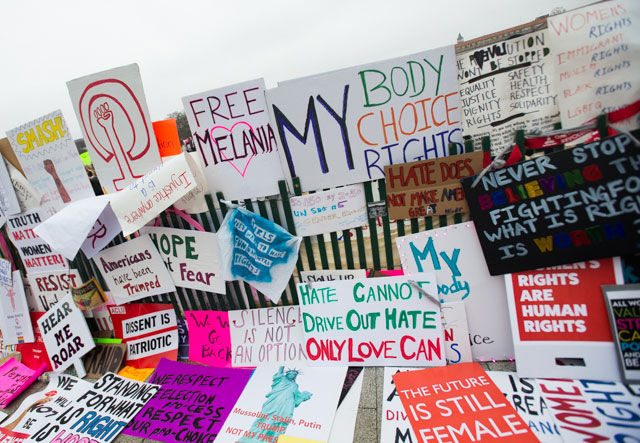 As the marches left Washington, DC, many left behind their homemade signs on a fence that crossed the White House lawn. (Photo: Zach Roberts)
As the marches left Washington, DC, many left behind their homemade signs on a fence that crossed the White House lawn. (Photo: Zach Roberts)
Additional photos by Rebekah Frumkin.
Truthout Is Preparing to Meet Trump’s Agenda With Resistance at Every Turn
Dear Truthout Community,
If you feel rage, despondency, confusion and deep fear today, you are not alone. We’re feeling it too. We are heartsick. Facing down Trump’s fascist agenda, we are desperately worried about the most vulnerable people among us, including our loved ones and everyone in the Truthout community, and our minds are racing a million miles a minute to try to map out all that needs to be done.
We must give ourselves space to grieve and feel our fear, feel our rage, and keep in the forefront of our mind the stark truth that millions of real human lives are on the line. And simultaneously, we’ve got to get to work, take stock of our resources, and prepare to throw ourselves full force into the movement.
Journalism is a linchpin of that movement. Even as we are reeling, we’re summoning up all the energy we can to face down what’s coming, because we know that one of the sharpest weapons against fascism is publishing the truth.
There are many terrifying planks to the Trump agenda, and we plan to devote ourselves to reporting thoroughly on each one and, crucially, covering the movements resisting them. We also recognize that Trump is a dire threat to journalism itself, and that we must take this seriously from the outset.
Last week, the four of us sat down to have some hard but necessary conversations about Truthout under a Trump presidency. How would we defend our publication from an avalanche of far right lawsuits that seek to bankrupt us? How would we keep our reporters safe if they need to cover outbreaks of political violence, or if they are targeted by authorities? How will we urgently produce the practical analysis, tools and movement coverage that you need right now — breaking through our normal routines to meet a terrifying moment in ways that best serve you?
It will be a tough, scary four years to produce social justice-driven journalism. We need to deliver news, strategy, liberatory ideas, tools and movement-sparking solutions with a force that we never have had to before. And at the same time, we desperately need to protect our ability to do so.
We know this is such a painful moment and donations may understandably be the last thing on your mind. But we must ask for your support, which is needed in a new and urgent way.
We promise we will kick into an even higher gear to give you truthful news that cuts against the disinformation and vitriol and hate and violence. We promise to publish analyses that will serve the needs of the movements we all rely on to survive the next four years, and even build for the future. We promise to be responsive, to recognize you as members of our community with a vital stake and voice in this work.
Please dig deep if you can, but a donation of any amount will be a truly meaningful and tangible action in this cataclysmic historical moment.
We’re with you. Let’s do all we can to move forward together.
With love, rage, and solidarity,
Maya, Negin, Saima, and Ziggy